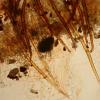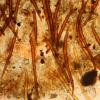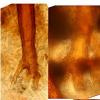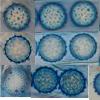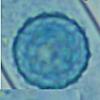
01-07-2016 02:17
 Viktorie Halasu
Viktorie Halasu
Good evening,I would like to ask your opinion on t

01-07-2016 14:56
 Rubén Martínez-Gil
Rubén Martínez-Gil
Hola a todos. Hace unos meses hice fotos micro de

28-06-2016 08:52
en semilla de CastaneaEjemplares en seco que he re

30-06-2016 16:41
Steve ClementsBonjour,On a trouvé cet asco sur un bûche dans u
 Good evening,
Good evening,I would like to ask your opinion on this Scutellinia:
Found along forest road in a decidous forest, growing on bare soil, probably periodically humid place with some rests of wood/bark, ca. 350 m s.m. Fruitbodies about 3 mm diam.
Spores perfectly globose, (15) 16,5-19,5 (20,4) um (squash mount in LACB).
Ornamentation: mixed small and big tubercules, or both rounded and conical warts, (0,3) 0,4-1,5 (1,9) um high, rarely confluent but sometimes interconnected with fine lines.
Marginal hairs: often sinuous, with simple or shortly bi-(tri-)furcate base, both obtuse and pointed ends, 294-420 (606) × 17,5-23 um.
Lateral hairs with simple or shortly bifurcate base, shorter, often bent/crooked.
Could it be S. heterosphaera nom.prov. or did I overlook some other similar species? And are there any other significant differences between S. heterosphaera and S. minor, except for the ornamentation?
Thank you very much.
Viktorie
This fits perfectly with the description I have for S heterosphaera and the specimens I have found some of which were id'd by Beñat. Although you are right about the differences between the two species sporal ornamentation the spores of S minor tend to be subglobose when immature so check those still in the ascii
Mal


